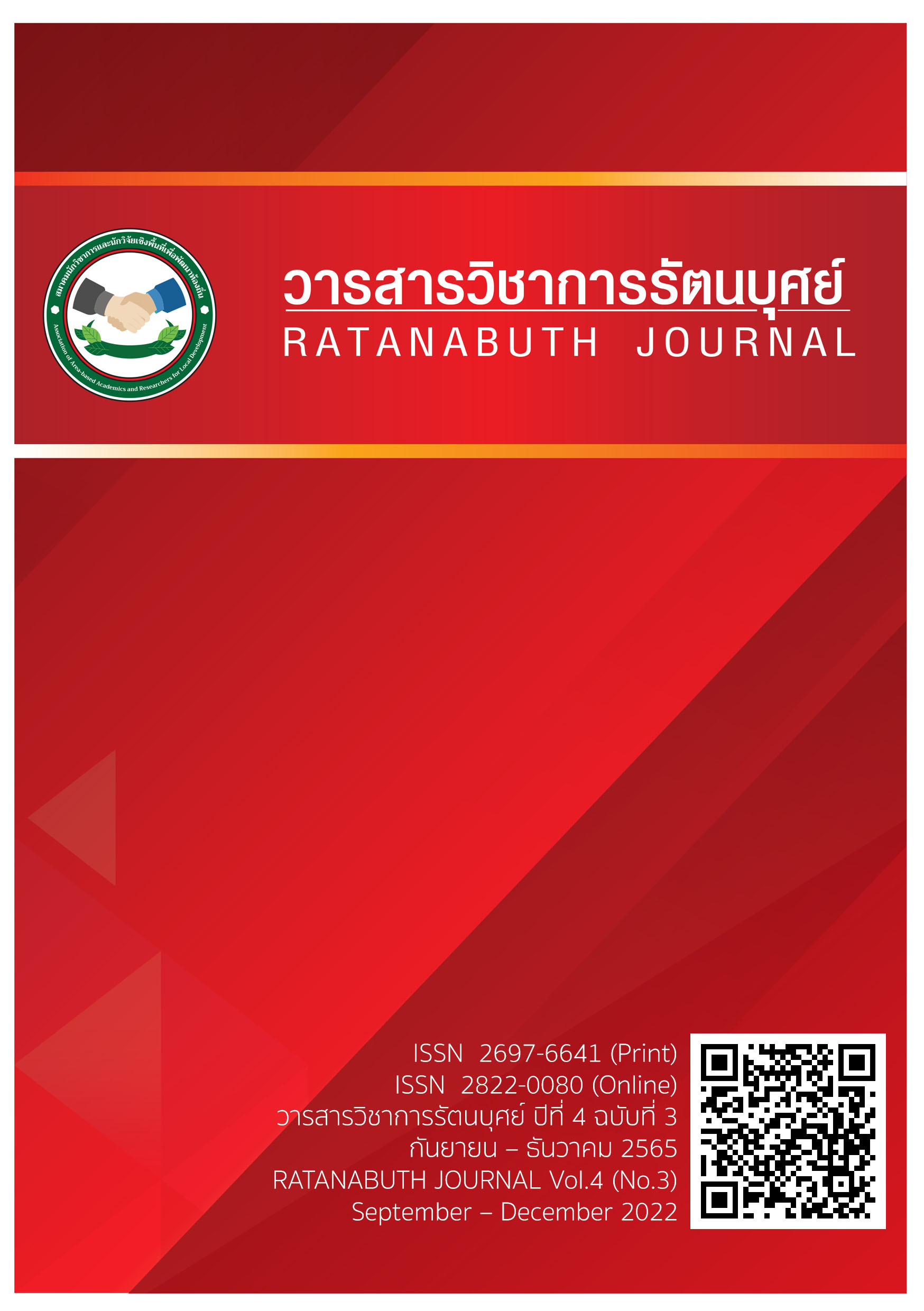Self-efficacy in Controlling Aggressive Behaviors among Adolescents in Pakse, Champasak, LAO PDR.
Main Article Content
Abstract
This research was to study the perception of self-efficacy in controlling aggressive behavior among adolescents. The sample group was A group of 50 young men and women aged 16-18 years in Pakse, Champasak Province, Lao PDR. The instrument used consisted of a questionnaire on perceptions of self-efficacy in controlling aggressive behavior. Data were analyzed with descriptive statistics. The results of the analysis revealed that the level of perception of self-efficacy in controlling aggressive behavior overall was moderate. The mean level was 4.38. As for the recommendations on the perception of self-efficacy in controlling aggressive behavior among Pakse adolescents, Champasak Province, Lao People's Democratic Republic found that psychosocial adaptation and a positive view of the world This allows adolescents to be aware of their own competencies, so they can use the basic information in planning for the development of perceptions. self-efficacy in controlling the aggressive behavior of The next suitable teenager and other variables should be studied to expand the effect of describing variables that are correlate and predict factors influencing perception self-efficacy in controlling aggressive behavior among adolescents.
Article Details

This work is licensed under a Creative Commons Attribution-NonCommercial-NoDerivatives 4.0 International License.
References
กรมพินิจและคุ้มครองเด็กและเยาวชน. (ออนไลน์). รายงานสถิติคดีประจําปี พ.ศ. 2557. สืบค้นเมื่อ 12 กรกฎาคม 2558. จาก: http://www. djop.moj.go.th/images/djopimage/yaer2557.pdf.
กรมสุขภาพจิต. (2555). รายงานงานประจําปีกรมสุขภาพจิต 2012. กรุงเทพมหานคร : บางกอกบล็อก.
จิราภา เต็งไตรรัตน์ และคณะ. (2554). จิตวิทยาทั่วไป. ฉบับพิมพ์ครั้งที่ 7. ธรรมศาสตร์ : สํานักพิมพ์ มหาวิทยาลัยธรรมศาสตร์.
นงลักษณ์ วิชัยรัมย์และคณะ. (2559). ความสัมพันธ์ระหว่างการปรับตัวด้านจิตสังคมและการมองโลกทางบวก กับการรับรู้สมรรถนะแห่งตนในการควบคุมพฤติกรรมก้าวร้าวในวัยรุ่น. วารสารพยาบาลกระทรวงสาธารณสุข. 26(2), 65-75.
บุญชม ศรีสะอาดและคณะ. (2548). หลักการวิจัยเบื้องต้น. กรุงเทพมหานคร: ศักดาพรการพิมพ์.
ปริญญา สิริอัตตะกุล และ นภัส ลิ่มอรุณ. (2564). พฤติกรรมก้าวร้าวในวัยรุ่นตอนปลาย:การประยุกต์ใช้แบบจําลองสมการโครงสร้าง. วารสารสหวิทยาการวิจัย : ฉบับบัณฑิตศึกษา (e-ISSN: 2730-3616) [35] 10(2), 35-43.
พิทักษ์พล บุณยมาลิก และคณะ. (2555). การพัฒนาและศึกษาความเที่ยงตรงของเครื่องมือประเมินเพื่อใช้ ในการป้องกันและแก้ไขความรุนแรงของนักเรียนอาชีวศึกษา. วารสารสมาคมจิตเวชแห่งประเทศไทย.57(1), 1-18.
รัตนา ตาบัง. (2550). ผลของโปรแกรมการกํากับตนเองต่อการรับรู้สมรรถนะแห่งตนในการควบคุมพฤติกรรม ก้าวร้าวของเด็กวัยรุ่น. วิทยานิพนธ์พยาบาลศาสตรมหาบัณฑิต, มหาวิทยาลัยเชียงใหม่.
ศรีเรือน แก้วกังวาน. (2551). ทฤษฎีจิตวิทยาบุคลิกภาพ. พิมพ์ครั้งที่ 15. กรุงเทพมหานคร: หมอชาวบ้าน.
สถาบันวิจัยประชากรและสังคม มหาวิทยาลัยมหิดล. (ออนไลน์). รายงานการสํารวจของสถาบันประชากรและสังคมปี พ.ศ. 2557. สืบค้นเมื่อ 12 ธันวาคม 2557 จาก: http://www.ipsr.mahidol.ac.th/ipsr/AnnualConference/ConferenceX/ Download.htm.
สิริพัช ชํานาญ. (2552). อัตมโนทัศน์การสนับสนุนทางสังคมและพฤติกรรมก้าวร้าวของนักเรียนอาชีวศึกษาในจังหวัดเชียงใหม่. วิทยานิพนธ์การศึกษามหาบัณฑิต, มหาวิทยาลัยเชียงใหม่.
สุชา จันทร์เอม และสุรางค์ จันทร์เอม. (2529). จิตวิทยาวัยรุ่น. กรุงเทพมหานคร: แพร่พิทยา.
สุพัฒนา เดชาติวงศ์ ณ อยุธยา. (2548). คู่มือบทความเพื่อสุขภาพจิต. กรุงเทพมหานคร: อักษรบัณฑิต.
อวิรุทธ์ ผลทรัพย์.. (2551). ศึกษาความสัมพันธ์ระหว่างปัจจัยบางประการกับความคิดเชิงบวกของนักเรียนชั้นมัธยมศึกษาปีที่ 3 ในเขตพื้นที่การศึกษานนทบุรี เขต 1. ปริญญานิพนธ์, กศ.ม.(การวิจัยและสถิติทางการศึกษา), กรุงเทพมหานคร : บัณฑิตวิทยาลัย, มหาวิทยาลัยศรีนครินทรวิโรจน์.
Arnett, JJ. (2010). Adolescence and emerging adulthood : A cultural approach . (4thed). Boston: PrenticeHall.
Bandura, A. (1977). Self-efficacy: Toward a unifying theory of behavioral change. Psychological Review 1977, 84: 191-215.
Bandura, A. (1986). Social foundations of thought and action. Englewood Cliffs, NJ : Prentice Hall 3.
Bandura, A. (2004). A.Swimming against the mainstream: The early years from chilly tributary to trans formative mainstream. Behavior Research and Therapy ; 2004 ; 42 : 618-630.
Carver, C.S.,M.F.Scheier, and J.K. Weintraub. (1989). Assessing coping strategies: A theoretically based approach. Journal of Personality and Social Psychology, 56 (1) : 267-283.
Demiray, B., & Freund, A. M. (2017). The psychological distance of memories : Examining causal relations with mood and self-esteem in young, middle-aged and older adults. Consciousness and Cognition, 49, 117-131.
Koizumi, M. (1985). Citrus canker: the world situation. In : L.W. Timmer. (eds.). Citrus canker : An international perspective. University of Forida, Lake Alfred.
Roy, C., Heather, AA. (1999). The royadaptatoin model. Stamford: Appletion & Lange.
Thorndike, R. M. (1978). Correlation Procedures for Research. New York: Gardner Press.


